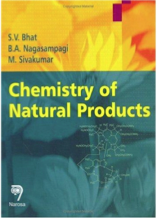Book Review






Have you ever wondered how you might synthesize cocaine in the lab? Have you ever been tempted to try and isolate caffeine from your coffee beans? Have you ever been interested in how you might synthesize the alkaloid poison strychnine to incapacitate your annoying lab partner in the most excessively complex yet most satisfying fashion? If so, the book the Chemistry of Natural Productsis for you! This book, written by S.V. Bhat, B.A. Nagasampagi, and M. Sivakumar, is a comprehensive reference source for chemists working with natural products. The authors wrote the book to provide a comprehensive book for their students at the Indian Institute of Technology, Bombay. Principally, the authors have aimed the text to be an “easy to read overview of natural products” for undergraduate and postgraduate students who are studying organic chemistry. This 821 page books contains twelve chapters covering topics in (1) Steroids, (2) Terpenoids, (3) Fatty acids and prostaglandins, (4) Alkaloids, (5) Amino acids, proteins and bioconversions, (6) Nucleic acids, (7) Carbohydrates, (8) Insect and plant growth regulators, (9) Plant phenolics, natural dyes and pigments, (10) Marine natural products, (11) Antibacterials, and (12) Vitamins. Each chapter contains sections on general introductory material, nomenclature, occurrence, isolation, detection, structure elucidation both by degradation and spectroscopic techniques, biosynthesis, synthesis, biological activity, and commercial application. As an example of how the compound information is organized within the chapter, the first chapter on steroids begins with general information on steroids as a broad class of compounds. The chapter then breaks down into subsections that explain the chemistry of a specific sub-class of compounds such as sterols, cholesterol, C-27 sterols, C-28 sterols, Vitamin D group molecules, bile acids, bile alcohols, sex hormones, estrogens, estradiol, estriol, and gestogens, to name a few.
Amongst the overview of chemical information provided for each compound, each section describes the compound’s general chemical properties such as formula weight, optical activity, melting point, IUPAC name, and spectroscopic data including UV, IR, 1H-NMR, 13C-NMR, and MS. Information on reactions that are of specific interest in regards to the compound (i.e. reduction to alcohol, formation of ketals and thioketals, formation of bishydroperoxides) are explained with a concise description of the synthetic procedure and reagents used. The reaction descriptions are enhanced with chemical structures and synthetic schemes. Of particular interest to the young aspiring organic chemist, most sections not only show how the product is produced biosynthetically but also show synthetic schemes and descriptions for the total synthesis of these products as well. Although such material may sound intimidating for those a couple years out of organic chemistry, it must be noted that the authors have gone to extreme lengths to include reviews on almost every organic chemistry and biochemistry topic relating to the natural products. Have you forgotten how to classify carbohydrates? It’s got a section on that. Is your knowledge of cyclohexane conformations a little foggy? It’s got a section on that. Have you totally forgotten about how to separate organic compounds from mixtures, spectroscopically characterize your products, or pretty much do anything from o. chem lab? It’s got sections on distillations, thin-layer chromatography, high performance liquid chromatography, IR, UV, NMR, amongst others…pretty much a review for everything you might forget. And for those who have already forgotten first semester biochemistry, it’s got a review of pretty much the entire semester within relevant sections.
Besides the chemical, synthetic, and theoretical information, each chapter provides citations of articles for further study as well as exercises to quiz your natural products knowledge. The broad overviews of each class of compound are filled with interesting facts about the history, occurrence, and biological activity of each class of compounds. This book is a mix of light general overviews and more in-depth synthetic chemistry. It may be a relaxing late-night read for only the nerdiest of chemistry students, but I’ll tell you what, it’ll sure look damn impressive on your nightstand.
“If we wish to catch up with Nature, we shall need to use the same methods as she does, and I can foresee a time in which physiological chemistry will not only make greater use of natural enzymes but also actually resort to creating synthetic ones.”
-Emily Fischer
Monday, January 30, 2012


Chemistry of Natural Products






